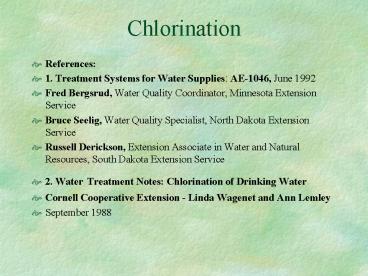Chlorination - PowerPoint PPT Presentation
1 / 8
Title:
Chlorination
Description:
Causes Smell and Bad Taste: Chlorine in water is not poisonous to humans or ... Some people object to the smell and/or taste of very small amounts of chlorine. ... – PowerPoint PPT presentation
Number of Views:755
Avg rating:3.0/5.0
Title: Chlorination
1
Chlorination
- References
- 1. Treatment Systems for Water Supplies AE-1046,
June 1992 - Fred Bergsrud, Water Quality Coordinator,
Minnesota Extension Service - Bruce Seelig, Water Quality Specialist, North
Dakota Extension Service - Russell Derickson, Extension Associate in Water
and Natural Resources, South Dakota Extension
Service - 2. Water Treatment Notes Chlorination of
Drinking Water - Cornell Cooperative Extension - Linda Wagenet and
Ann Lemley - September 1988
2
What impurities will chlorination remove?
- Chlorination is a water treatment that destroys
disease-causing bacteria, nuisance bacteria,
parasites and other organisms. - Chlorination also removes soluble iron, manganese
and hydrogen sulfide from water.
3
- Disease-causing bacteria can infect humans in
several ways. Disease-causing organisms are
transmitted from host to host in many ways
including through a contaminated water supply. - If a water supply becomes contaminated,
elimination of the source is the most permanent
solution. Chlorination is used to kill
disease-causing bacteria in a water supply.
4
Advantages of chlorination
- 1. Controls Disease-Causing Bacteria
- 2. Controls Nuisance Organisms Chlorine
treatment will control nuisance organisms such as
iron, slime and sulfate-reducing bacteria. - 3. Mineral Removal Clorination removes large
amounts of iron, manganese and hydrogen sulfide
from water by oxidizing them into filterable
insoluble forms.
5
Disadvantages of chlorination
- 1. No Nitrate Removal Chlorine will not remove
nitrates from water. - 2. Causes Smell and Bad Taste Chlorine in water
is not poisonous to humans or animals. However,
if the concentration is great enough the water
will taste bad so consumption may be reduced.
Some people object to the smell and/or taste of
very small amounts of chlorine.
6
The chlorination process
- 1. Chlorine demand is the amount of chlorine
required to kill bacteria, oxidize iron or other
elements in the water. - 2. Free available chlorine residual is the amount
of chlorine remaining in the water after the
chlorine demand has been met. - 3. Contact time is the amount of time that the
chlorine is present in the water. The combination
of chlorine residual and contact time determines
the effectiveness of the chlorination treatment.
7
Chlorine treatment
- Chlorine readily combines with chemicals
dissolved in water, microorganisms, small
animals, plant material, tastes, odors, and
colors. These components "use up" chlorine and
comprise the chlorine demand of the treatment
system. It is important to add sufficient
chlorine to the water to meet the chlorine demand
and provide residual disinfection.
8
Trade-offs
- Amounts of Chlorine used must be enough to kill
and remove all undesired organisms and minerals
while being small enough so it does not adversely
affect the taste or smell of the water. - These amounts are tested by experimentation and
controlled by local government agencies.































